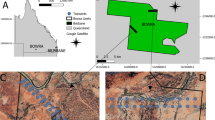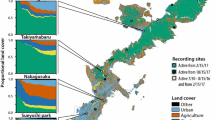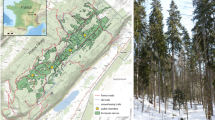Abstract
Context
While remote sensing imagery is effective for quantifying land cover changes across large areas, its utility for directly assessing the response of animals to disturbance is limited. Soundscapes approaches—the recording and analysis of sounds in a landscape—could address this shortcoming.
Objectives
In 2011, a massive wildfire named “the Horseshoe 2 Burn” occurred in the Chiricahua National Monument, Arizona, USA. We evaluated the impact of this wildfire on acoustic activity of animal communities.
Methods
In 2013, soundscape recordings were collected over 9 months in 12 burned and 12 non-burned sites in four ecological systems. The seasonal and diel biological acoustic activity were described using the “Bioacoustic Index”, a detailed aural analysis of sound sources, and a new tool called “Sonic Timelapse Builder” (STLB).
Results
Seasonal biophony phenology showed a diurnal peak in June and a nocturnal peak in October in all ecological systems. On June mornings, acoustic activity was lower at burned than at non-burned sites in three of four ecological systems, due to a decreased abundance of cicadas directly impacted by the death of trees. Aural analyses revealed that 55% of recordings from non-burned sites contained insect sounds compared to 18% from burned sites. On October nights, orthopteran activity was more prevalent at some burned sites, possibly due to post-fire emergence of herbaceous.
Conclusions
Soundscape approaches can help address long-term conservation issues involving the responses of animal communities to wildfire. Acoustic methods can serve as a valuable complement to remote sensing for disturbance-based landscape management.






Similar content being viewed by others
References
Acevedo MA, Villanueva-Rivera LJ (2006) Using automated digital recording systems as effective tools for the monitoring of birds and amphibians. Wildl Soc Bull 34:211–214
Bates D, Maechler M, Bolker B, Walker S (2015) Fitting linear mixed-effects models using lme4. J Stat Softw 67:1–48
Boelman NT, Asner GP, Hart PJ, Martin RE (2007) Multi-trophic invasion resistance in Hawai’ I : bioacoustics, field surveys, and airborne remote sensing. Ecol Appl 17:2137–2144
Bolker BM, Brooks ME, Clark CJ, Geange SW, Poulsen JR, Stevens MH, White JS (2009) Generalized linear mixed models: a practical guide for ecology and evolution. Trends Ecol Evol 24:127–135
Bond WJ, Woodward FI, Midgley GF (2005) The global distribution of ecosystems in a world without fire. New Phytol 165:525–538
Box GEP, Cox DR (1964) An analysis of transformations (with discussion). J R Stat Soc B 26:211–252
Callaham MA Jr, Blair JM, Todd TC, Kitchen DJ, Whiles MR (2003) Macroinvertebrates in North American tallgrass prairie soils: effects of fire, mowing, and fertilization on density and biomass. Soil Biol Biochem 35:1079–1093
Callaham MA Jr, Whiles MR, Meyer CK, Brock BL, Charlton RE (2000) Feeding ecology and emergence production of annual cicadas (Homoptera: Cicadidae) in tallgrass prairie. Oecologia 123:535–542
Chiavacci SJ, Bednarz JC, McKay T (2014) The emergence densities of annual cicadas (Hemiptera: Cicadidae) increase with sapling density and are greater near edges in a Bottomland Hardwood Forest. Environ Entomol 43:859–867
Comer P, Faber-Langendoen D, Evans R, Gawler S, Josse C, Kittel G, Menard S, Pyne M, Reid M, Schulz K, Snow K, Teague J (2003) Ecological systems of the United States: a working classification of U.S. terrestrial systems. NatureServe, Arlington, Virginia
Crotteau JS, Varner JM, Ritchie MW (2013) Post-fire regeneration across a fire severity gradient in the southern Cascades. For Ecol Manage 287:103–112
Dale VH, Joyce LA, McNulty S, Neilson RP, Ayres MP, Flannigan MD, Hanson PJ, Irland LC, Lugo AE, Peterson CJ, Simberloff D (2001) Climate change and forest disturbances: climate change can affect forests by altering the frequency, intensity, duration, and timing of fire, drought, introduced species, insect and pathogen outbreaks, hurricanes, windstorms, ice storms, or landslides. Bioscience 51:723–734
Deichmann JL, Hernández-Serna A, Delgado Cornejo JA, Campos-Cerqueira M, Aide TM (2017) Soundscape analysis and acoustic monitoring document impacts of natural gas exploration on biodiversity in a tropical forest. Ecol Ind 74:39–48
Depraetere M, Pavoine S, Jiguet F, Gasc A, Duvail S, Sueur J (2012) Monitoring animal diversity using acoustic indices: implementation in a temperate woodland. Ecol Ind 13:46–54
Digby A, Towsey M, Bell BD, Teal PD (2013) A practical comparison of manual and autonomous methods for acoustic monitoring. Methods Ecol Evol 4:675–683
Diwakar S, Balakrishnan R (2007) The assemblage of acoustically communicating crickets of a tropical evergreen forest in southern India: call diversity and diel calling patterns. Bioacoustics 16:113–135
Drewry GE, Rand AS (1983) Characteristics of an acoustic community: Puerto Rican frogs of the genus Eleutherodactylus. Copeia 4:941–953
Dumyahn SL, Pijanowski BC (2011) Soundscape conservation. Landscape Ecol 26:1327–1344
Duncan BW, Schmalzer PA (2004) Anthropogenic influences on potential fire spread in a pyrogenic ecosystem of Florida, USA. Landscape Ecol 19:153–165
Ellwood ER, Diez JM, Ibánez I, Primack RB, Kobori H, Higuchi H, Silander JA (2012) Disentangling the paradox of insect phenology: are temporal trends reflecting the response to warming? Oecologia 168:1161–1171
Engle DM, Fuhlendorf SD, Roper A, JrDM Leslie (2008) Invertebrate community response to a shifting mosaic of habitat. Rangel Ecol Manag 61:55–62
Fairbrass AJ, Rennett P, Williams C, Titheridge H, Jones KE (2017) Biases of acoustic indices measuring biodiversity in urban areas. Ecol Ind 83:169–177
Farina A, Gage SH, Salutari P (2018) Testing the ecoacoustics event detection and identification (EEDI) model on mediterranean soundscapes. Ecol Ind 85:698–715
Farina A, James P (2016) The acoustic communities: definition, description and ecological role. Biosystems 147:11–20
Farina A, Pieretti N (2014) Sonic environment and vegetation structure: a methodological approach for a soundscape analysis of a Mediterranean maqui. Ecol Inform 21:120–132
Fonseca PJ (2014) Cicada acoustic communication. In: Berthold H (ed) Insect hearing and acoustic communication, vol 1. Springer, Berlin, pp 101–121
Fox J, Weisberg S (2011) An R companion to applied regression, 2nd edn. Sage, Thousand Oaks, CA
Fuller S, Axel AC, Tucker D, Gage SH (2015) Connecting soundscape to landscape: which acoustic index best describes landscape configuration? Ecol Ind 58:207–215
Gage SH, Axel AC (2014) Visualization of temporal change in soundscape power of a Michigan lake habitat over a 4-year period. Ecol Inform 21:100–109
Gasc A, Francomano D, Dunning JB, Pijanowski BC (2016) Future directions for soundscape ecology: the importance of ornithological contributions. Auk 134:215–228
Gasc A, Pavoine S, Lellouch L, Grandcolas P, Sueur J (2015) Acoustic indices for biodiversity assessments: analyses of bias based on simulated bird assemblages and recommendations for field surveys. Biol Cons 191:306–312
Gasc A, Sueur J, Jiguet F, Devictor V, Grandcolas P, Burrow C, Depraetere M, Pavoine S (2013a) Assessing biodiversity with sound: do acoustic diversity indices reflect phylogenetic and functional diversities of bird communities? Ecol Ind 25:279–287
Gasc A, Sueur J, Pavoine S, Pellens R, Grandcolas P (2013b) Biodiversity sampling using a global acoustic approach: contrasting sites with microendemics in New Caledonia. PLoS ONE 8:e65311
Guyette RP, Muzika RM, Dey DC (2002) Dynamics of an anthropogenic fire regime. Ecosystems 5:472–486
Halpin PN (1997) Global climate change and natural-area protection: management responses and research directions. Ecol Appl 7:828–843
Hannah L, Midgley G, Andelman S, Araújo M, Hughes G, Martinez-Meyer E, Pearson R, Williams P (2007) Protected area needs in a changing climate. Front Ecol Environ 5:131–138
Heinselman ML (1981) Fire intensity and frequency as factors in the distribution and structure of northern ecosystems. In: Mooney HA, Bonnicksen TM, Christensen NL, Lotan JE, Reiners WA (eds) Proceedings of the conference fire regimes and ecosystem properties, Honolulu. USDA Forest Service, General Technical Report WO–26, Washington DC, pp 7–57
Hill KB, Marshall DC, Moulds MS, Simon C (2015) Molecular phylogenetics, diversification, and systematics of Tibicen Latreille 1825 and allied cicadas of the tribe Cryptotympanini, with three new genera and emphasis on species from the USA and Canada (Hemiptera: Auchenorrhyncha: Cicadidae). Zootaxa 3985:219–251
Holm S (1979) A simple sequentially rejective multiple test procedure. Scand J Stat 6:65–70
Joo W, Gage SH, Kasten EP (2011) Analysis and interpretation of variability in soundscapes along an urban-rural gradient. Landscape Urban Plan 103:259–276
Krause B, Gage SH, Joo W (2011) Measuring and interpreting the temporal variability in the soundscape at four places in Sequoia National Park. Landscape Ecol 26:1247–1256
Kuehne LM, Padgham BL, Olden JD (2013) The soundscapes of lakes across an urbanization gradient. PLoS ONE 8:e55661
Lee BPY, Davies ZG, Struebig MJ (2017) Smoke pollution disrupted biodiversity during the 2015 El Niño fires in Southeast Asia. Environ Res Lett 12:094022
Lellouch L, Pavoine S, Jiguet F, Glotin H, Sueur J (2014) Monitoring temporal change of bird communities with dissimilarity acoustic indices. Methods Ecol Evol 5:495–505
Ligges U, Krey S, Mersmann O, Schnackenberg S (2013) tuneR: analysis of music. http://r-forge.r-project.org/projects/tuner/
Lomolino MV, Pijanowski BC, Gasc A (2015) The silence of biogeography. J Biogeogr 42:1187–1196
Luczkovich JJ, Pullinger RC, Johnson SE, Sprague MW (2008) Identifying sciaenid critical spawning habitats by the use of passive acoustics. Trans Am Fish Soc 137:576–605
Méndez-Barroso LA, Vivoni ER, Watts CJ, Rodríguez JC (2009) Seasonal and interannual relations between precipitation, surface soil moisture and vegetation dynamics in the North American monsoon region. J Hydrol 377:59–70
Militino AF (2010) Mixed effects models and extensions in ecology with R. J R Stat Soc Ser A 173:938–939
Mullet TC, Gage SH, Morton JM, Huettmann F (2016) Temporal and spatial variation of a winter soundscape in south-central Alaska. Landscape Ecol 31:1117–1137
Pausas JG, Llovet J, Rodrigo A, Vallejo R (2008) Are wildfires a disaster in the Mediterranean basin?—A review. Int J Wildl Fire 17:713–723
Pekin BK, Jung J, Villanueva-Rivera LJ, Pijanowski BC, Ahumada JA (2012) Modeling acoustic diversity using soundscape recordings and LIDAR-derived metrics of vertical forest structure in a neotropical rainforest. Landscape Ecol 27:1513–1522
Peters DCP, Lugo AE, Chapin FS III, Pickett STA, Duniway M, Rocha AV, Sawanson FJ, Laney C, Jones J (2011) Cross-system comparisons elucidate disturbance complexities and generalities. Ecosphere 2:art81
Pieretti N, Farina A, Morri D (2011) A new methodology to infer the singing activity of an avian community: the Acoustic Complexity Index (ACI). Ecol Indic 11:868–873
Pijanowski BC, Farina A, Gage SH, Dumyahn SL, Krause BL (2011a) What is soundscape ecology? An introduction and overview of an emerging new science. Landscape Ecol 26:1213–1232
Pijanowski BC, Villanueva-Rivera LJ, Dumyahn SL, Farina A, Krause BL, Napoletano BM, Gage SH, Pieretti N (2011b) Soundscape ecology: the science of sound in the landscape. Bioscience 61:203–216
Powell BF, Schmidt CA, Halvorson WL, Anning P (2009) Vascular plant and vertebrate inventory of Chiricahua national monument (No. 2008-1023). US Geological Survey
R Core Team (2014) R: a language and environment for statistical computing. R Foundation for Statistical Computing, Vienna, Austria. http://www.R-project.org/
Röder A, Hill J, Duguy B, Alloza JA, Vallejo R (2008) Using long time series of Landsat data to monitor fire events and post-fire dynamics and identify driving factors. A case study in the Ayora region (eastern Spain). Remote Sens Environ 112:259–273
Ruse MG, Hasselquist D, Hansson B, Tarka M, Sandsten M (2016) Automated analysis of song structure in complex birdsongs. Anim Behav 112:39–51
Sanborn AF, Phillips PK (2013) Biogeography of the cicadas (Hemiptera: Cicadidae) of North America, north of Mexico. Diversity 5:166–239
Sankupellay M, Towsey M, Truskinger A, Roe P (2015) Visual fingerprints of the acoustic environment. In: Proceedings of the IEEE international symposium on big data visual analytics. IEEE, New York
Schafer RM (1977) The Soundscape. Our sonic environment and the tuning of the world. Destiny Books, Vancouver
Stephens SL, Agee JK, Fule PZ, North MP, Romme WH, Swetnam TW, Turner MG (2013) Managing forests and fire in changing climates. Science 342:41–42
Sueur J, Aubin T, Simonis C (2008a) Seewave: a free modular tool for sound analysis and synthesis. Bioacoustics 18:213–226
Sueur J, Farina A, Gasc A, Pieretti N, Pavoine S (2014) Acoustic indices for biodiversity assessment and landscape investigation. Acta Acust United Acust 100:772–781
Sueur J, Pavoine S, Hamerlynck O, Duvail S (2008b) Rapid acoustic survey for biodiversity appraisal. PLoS ONE 3:e4065
Swetnam TW (1993) Fire history and climate change in giant sequoia groves. Science 262:885
Swetnam TW, Baisan CH, Caprio AC, Brown PM (1992) Fire history in a Mexican oak-pine woodland and adjacent montane conifer gallery forest in southeastern Arizona. Paper presented at the symposium on the ecology and management of Oak and Associated Woodlands: perspectives in the Southwestern United States and Northern Mexico, Sierra Vista, AZ, USA, April 27–30, 1992
Syphard AD, Clarke KC, Franklin J (2007) Simulating fire frequency and urban growth in southern California coastal shrublands, USA. Landscape Ecol 22:431–445
Towsey M, Wimmer J, Williamson I, Roe P (2014a) The use of acoustic indices to determine avian species richness in audio-recordings of the environment. Ecol Inform 21:110–119
Towsey M, Zhang L, Cottman-Fields M, Wimmer J, Zhang J, Roe P (2014b) Visualization of long-duration acoustic recordings of the environment. Proc Comput Sci 29:703–712
Truskinger A, Cottman-Fields M, Johnson D, Roe P (2013) Rapid scanning of spectrograms for efficient identification of bioacoustic events in big data. Paper presented at IEEE 9th international conference on eScience (eScience), Beijing, China, 22–25 October, 2013
Turner MG (2010) Disturbance and landscape dynamics in a changing world. Ecology 91:2833–2849
Turner MG, Hargrove WW, Gardner RH, Romme WH (1994) Effects of fire on landscape heterogeneity in Yellowstone National Park, Wyoming. J Veg Sci 5:731–742
Turner MG, Romme WH, Gardner RH, O’Neill RV, Kratz TK (1993) A revised concept of landscape equilibrium: disturbance and stability on scaled landscapes. Landscape Ecol 8:213–227
U.S. Geological Survey, Gap Analysis Program (GAP) (2011) National land cover, Version 2
U.S. Geological Survey and the U.S. Forest Service (2013) Monitoring trends in burn severity assessment of fire information: AZ3182010921120110508. Raster digital data for satellite imagery and derived data for fire perimeters. Sioux Falls, South Dakota or Salt Lake City, Utah. http://edc.usgs.gov or http://www.fs.fed.us/eng/rsac/ and http://www.mtbs.gov/
Vankat JL (1977) Fire and man in Sequoia National Park. Ann Assoc Am Geogr 67:17–27
Venables WN, Ripley BD (2002) Modern applied statistics with S, 4th edn. Springer, New York
Viedma O, Melia J, Segarra D, Garcia-Haro J (1997) Modeling rates of ecosystem recovery after fires by using Landsat TM data. Remote Sens Environ 61:383–398
Villanueva-Rivera LJ, Pijanowski BC (2012) Pumilio: a web-based management system for ecological recordings. Bull Ecol Soc Am 93:71–81
Villanueva-Rivera LJ, Pijanowski BC (2015) soundecology: soundscape ecology. R package version 1.3.1. http://CRAN.R-project.org/package=soundecology
Warshall P (1995) The Madrean sky island archipelago: a planetary overview. In: DeBano LF, Gottfried GJ, Hamre RH, Edminster CB, Dolliott PFF, Ortega-Rubio A (eds) Biodiversity and management of the Madrean Archipelago: the sky islands of Southern United States and Northwestern Mexico. USDA Forest Service General Technical Report RM-GTR-264, pp 6–18
Watts CJ, Scott RL, Garatuza-Payan J, Rodriguez JC, Prueger JH, Kustas WP, Douglas M (2007) Changes in vegetation condition and surface fluxes during NAME 2004. J Clim 20:1810–1820
White PS, Pickett STA (1985) Natural disturbance and patch dynamics: an introduction. In: Pickett STA, White PS (eds) The ecology of natural disturbance and patch dynamics. Academic Press, New york, pp 3–13
Wildlife Acoustics, Inc. Bioacoustics software and field recording equipment website. http://www.wildlifeacoustics.com/. Accessed 1 January 2014
Williams KS, Smith KG, Stephen FM (1993) Emergence of 13-yr periodical cicadas (Cicadidae: Magicicada): phenology, mortality, and predator satiation. Ecology 74:1143–1152
Yeates GW, Lee WG (1997) Burning in a New Zealand snow-tussock grassland: effects on vegetation and soil fauna. N Zeal J Ecol 1:73–79
Zhao Z, Zhang SH, Xu ZY, Bellisario K, Dai NH, Omrani H, Pijanowski BC (2017) Automated bird acoustic event detection and robust species classification. Ecol Inform 39:99–108
Acknowledgements
We would like to thank our field assistant Karen Krebbs as well as Maura Thoenes Buckley from the Chiricahua National Monument for their help in the protocol development and the collection of the data. Additionally, we would like to thank Matthew Harris and Marc Manceau for their help in the field and their work in the documentation of this study. We are grateful for the helpful and constructive comments of the two anonymous reviewers.
Funding
This work was partially funded by the Wright Forestry Fund of the Department of Forestry and Natural Resources, the Purdue University Graduate School, National Science Foundation Research Coordination Networks (NSF RCN #1114945), National Science Foundation Division of Information and Intelligent Systems (NSF IIS #0705836), Purdue University’s Center for the Environment, the United States Department of Education’s Graduate Area of National Needs (GANN) Program, the McIntire-Stennis Cooperative Forestry Research Program of the U.S. Department of Agriculture, the College of Agriculture at Purdue University, and the Executive Vice President for Research and Engagement at Purdue University.
Author information
Authors and Affiliations
Corresponding author
Ethics declarations
Conflict of interest
The authors declare that they have no conflicts of interest.
Electronic supplementary material
Below is the link to the electronic supplementary material.
Rights and permissions
About this article
Cite this article
Gasc, A., Gottesman, B.L., Francomano, D. et al. Soundscapes reveal disturbance impacts: biophonic response to wildfire in the Sonoran Desert Sky Islands. Landscape Ecol 33, 1399–1415 (2018). https://doi.org/10.1007/s10980-018-0675-3
Received:
Accepted:
Published:
Issue Date:
DOI: https://doi.org/10.1007/s10980-018-0675-3




